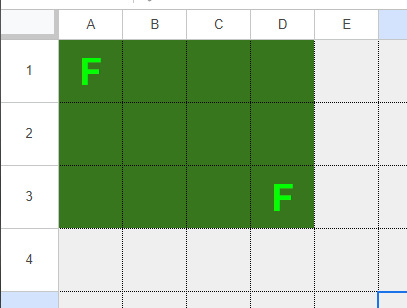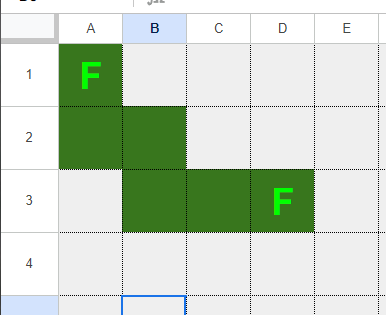You might also be interested in these,
https://perchance.org/outpost-5-mission-map-generator
https://perchance.org/outpost-5-mission-generator
skeolan
Recent community posts
I think you could adapt the rules for Mission Creation on pages 30-32 to go without the "die drop" method - or even needing to use a grid-coordinate system at all - if you're willing to approach it as an exercise in building a "pointcrawl" instead of a "mapcrawl."
I'm sure there are lots of ways to approach this; I ended up bolting on the "In the Heart of the Delve & Dangerous" rules as a starting point.
If you didn't want to add in a whole new subsystem for this, I think you could just about get there by taking the rules-as-written in the rulebook pages 30-32, with a little help from the Random Encounter table on p.16.
You would need to modify the "Mission Site Map" mechanism on page 31 though, we'd need a different engine to let us generate the pointcrawl "stepwise" as we're walking through the mission site. But we can stay true to the design intent! Those rules are meant to generate exactly 12 Areas per Level, connected by Passages and containing Features, right?
So, start with the PCs entering Area 1, and follow something like this procedure every time the PCs enter a new Area:
- Determine Area Size -- roll 1d6 to determine a "die size" for the Area (1=d4, 2=d6, 3=d8, 4=d10, 5=d12, 6=d20)
- Roll the appropriate die to determine exact number of 10' squares if it seems useful to do so?
- Determine Area Features -- For *each* of the tables on page 32 (Challenges; Encounters; Discoveries; Site Features):
- Roll 1d6 on the Random Encounter table (Result column), on page 16.
- 1 ("Encounter") -- a "high intensity" feature of that type is in the room.
- 2-3 ("Sighting") -- a "low intensity" feature of that type is in the room.
- 4-6 ("No Action") -- no noteworthy feature of that type is in the room.
- If a high- or low-intensity feature of a given type is present, roll 2d6 on the corresponding table.
- Scale the resulting challenge, entity, or discovery relative to the "intensity" rating, and flavor it according to the 2d6 roll.
- Examples:
- I roll a 3 ("Low Intensity") for Challenge, a 5 ("Nothing") for Encounter, and a 1 ("High Intensity") for Discovery.
- My Challenge Table roll is (4, 2) [Containment, Defence]
- My Discovery roll is (3, 3) [Weapon, Food / Materials] -- I flip a coin and get "Food" --
- I'll rule that a [Weapon / Food] Discovery says we're looking at military rations -- and they're the dominant feature in the room, with a comparatively minor [Containment / Defence] challenge, so let's say the PCs have found a storage closet - inside is a case of MREs (2d6 Food) -- but it's contained in a Locked Supply Crate. The crate has a low-ish DC (10?) to bypass the lock; failing the roll will destroy 1d6 Food.
- Roll 1d6 on the Random Encounter table (Result column), on page 16.
- Determine Area Passages -- Randomly determine a number of Passages leading out of the Area, say 1d3 for a room of size d8 or lower; 1d6 for larger rooms.
- Roll on the Exploration column for each Passage. Some of these results (e.g. "Choice of paths" or "loop") will need some interpretation.
- Number the Areas at the end of each Passage using the next available Area Number, max 12.
- Once all 12 Areas are defined on the "map", any new Passages will not lead to new Areas, and instead should (d10 roll):
- 0-6 -- Connect back to existing rooms (rolling randomly to determine which ones)
- 7-8 -- Offer an exit from the Mission site
- 9 -- Link to another Level
With the above approach, the Areas become a list of descriptions rather than a coordinate map, and the only thing that matters is how to move from one to the next.
Let me know what you think!
Hi NamelessDesigner,
We’ve been kicking around a house rule idea that, per rules as written, the Outpost can use its own automated facilities to do ONE Outpost Project, but a number of PCs working together on another task can try to complete one or more additional Projects. What would you recommend as a way to handle this, within the intended design /pacing mechanisms of your game rules?
Thanks!
A Perchance user /u/Vionet20 (not me) created these, they seem like a great convenience tool!
https://perchance.org/outpost-5-char-gen
https://perchance.org/outpost-5-sector-map-generator
https://perchance.org/outpost-5-mission-generator
https://perchance.org/outpost-5-mission-map-generator
I've been tinkering with something similar in Google Sheets, but these are much less fiddly than my way :)
Howdy! My group and I have finished creating our first Outpost 5 colony, generated a map, created characters, and gotten geared up. We have a few randomly-generated leads to follow on the sector map, and we're eager to get started exploring this strange and dangerous new world.
As we get ready to start this up, I realize I'm feeling uncertain about the intended play-style w.r.t. moving back and forth from the Outpost Phase to the Mission Phase (rulebook page 5)...
- When the game begins, are we in the Outpost Phase or do we dive right into a Mission Phase?
- Given an Outpost Phase cycle is a calendar month, is it reasonable to think there may be more than one Mission Phase per Outpost Phase, depending on distance and travel time? Or is the game set up with the expectation that there's only one Mission Phase and one Outpost Phase per Cycle?
Hi again! We're working through the Sector Map creation process and I'm wondering how to interpret the coordinate-pair results in Step 2, "Add Terrain"
Here's an example:
- I roll d6 to see how many terrain features the map has -- I rolled 1.
- Roll d6 on the Terrain Table to determine terrain type -- I rolled 3, "Forest".
- Roll 2d20 for start coordinates [x, y] -- I rolled 1 and 1, so my forest starts at [1,1]
- Roll 2d20 for end coordinates [x, y] -- I rolled 4 and 3, so my forest ends at [4, 3]
Is this a *rectangle* of forest from [1,1] to [4,3]?

Or a *line* of forest going straight-ish from [1,1] to [4,3]?

Hi there! I'm back :)
A. Is it intended that the larger vehicles are drastically more power-efficient than smaller ones? For 1 Power, I can move in any of the following ways (assuming I have all three in the garage):
- Quad Bike with 1 person and 10 storage up to 10 squares (If 1 person = 10 storage, let's call this 200 "transport units")
- Lunar Roving Buggy with 4 people and 20 storage up to 20 squares (1200 "transport units")
- Small Shuttle with 8 people and 100 storage up to 40 squares (7200 "transport units")
It seems like burning a unit of Power to send someone out alone on the Quad Bike would feel like a bit of a waste compared to waiting for the Small Shuttle to come back into the hangar so I could take more people, farther, for the same 1 unit of Power. Am I missing something?
B. Do vehicles need to carry their own Power to activate on turns where they're out in the field, or do I 'beam' them power from the Outpost somehow? e.g. if I drive my Buggy 10 squares away from the base on turn 1, can I spend Power from the base, or only from the Buggy's "local" storage, in order to power it again for Turn 2?
On the Outpost Phase, in some of the Project tables, some results read like the following (from Mining Table):
> Minor Success, gain d6 dis. material resources
>Major Success, gain d6 adv. material resources
Similar for Power and Research... but unless I'm missing it, there doesn't seem to be any explanation of what those abbreviations "dis" and "adv" mean?
This game seems awesome, and I'm excited to try it out with my group!
... but I know that sometime early in the first session, one of my players is going to try to kill something with a crowbar, a power drill, or a welding torch. :-D
What do you recommend for damage values on those items or other improvised weapons? Most "real" weapons seem to do 1-2 damage, should these be 1-1 instead perhaps? Or 1-2, but apply disadvantage to the attack?


